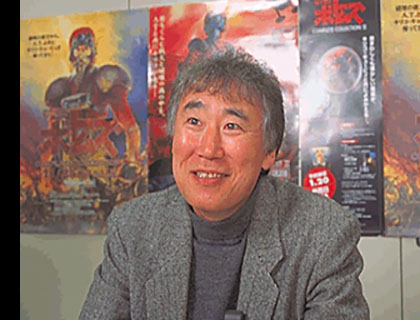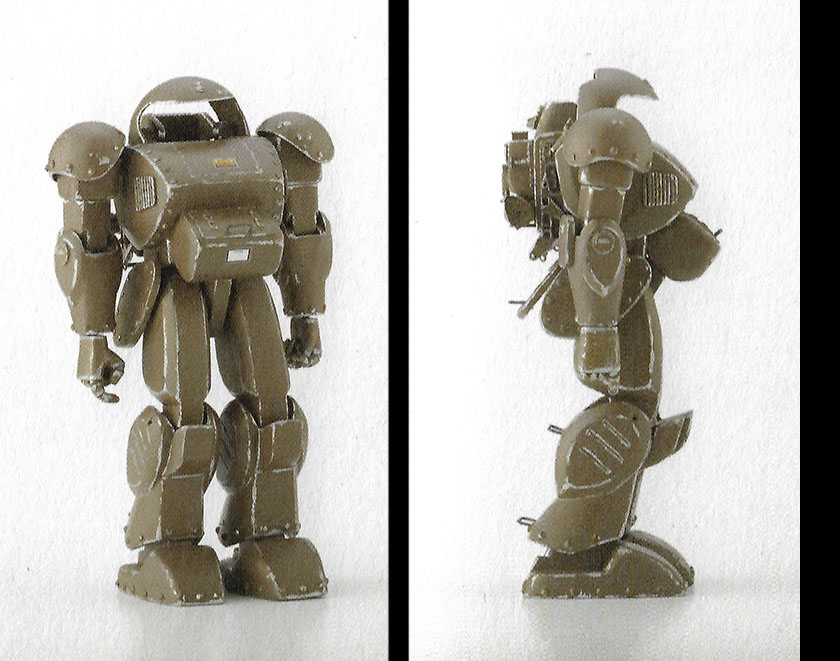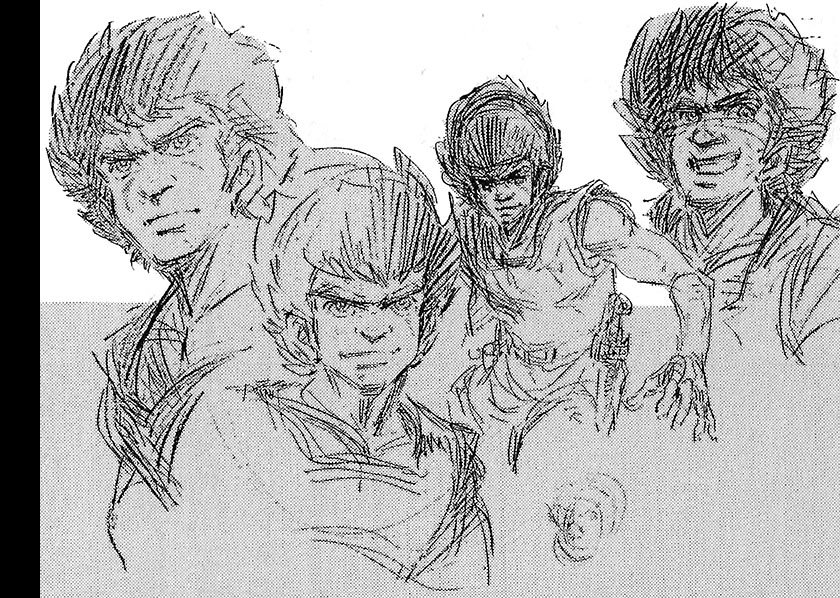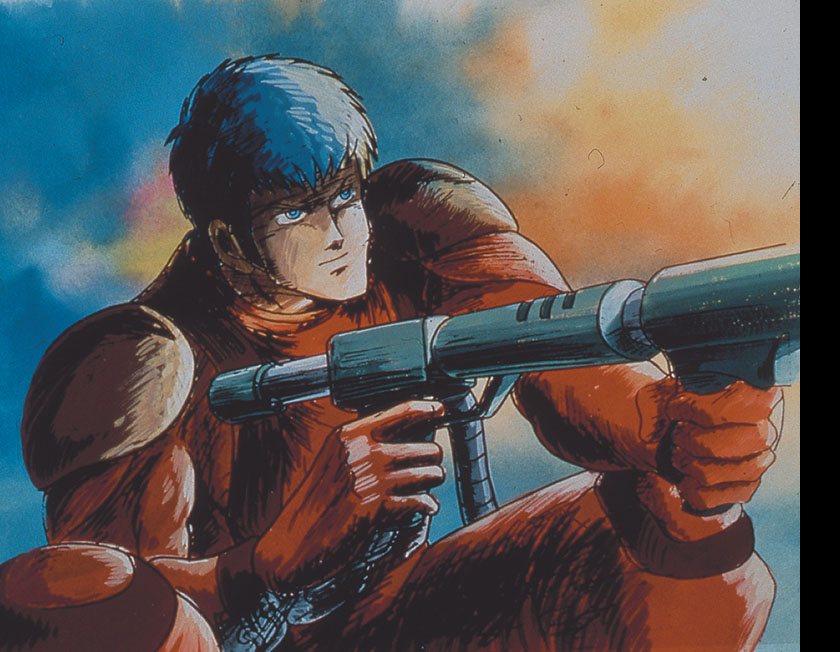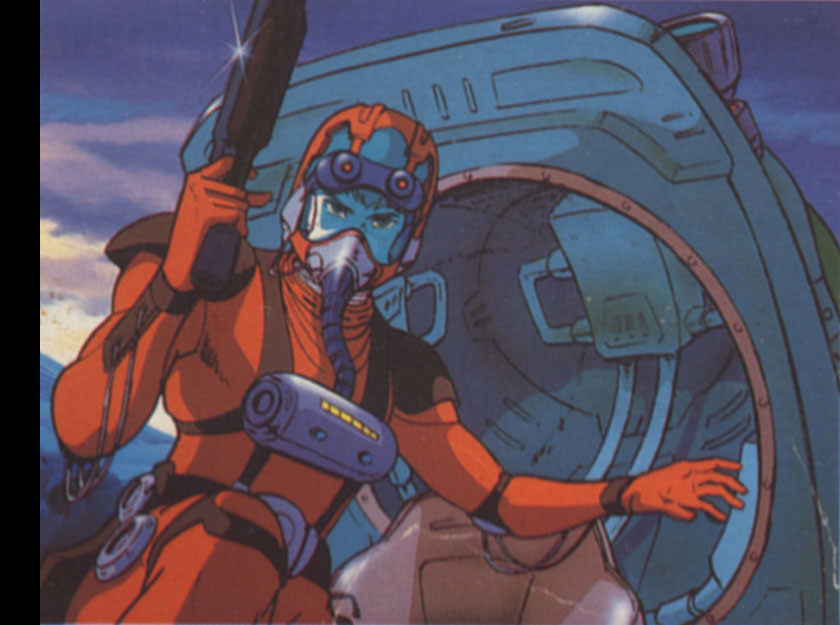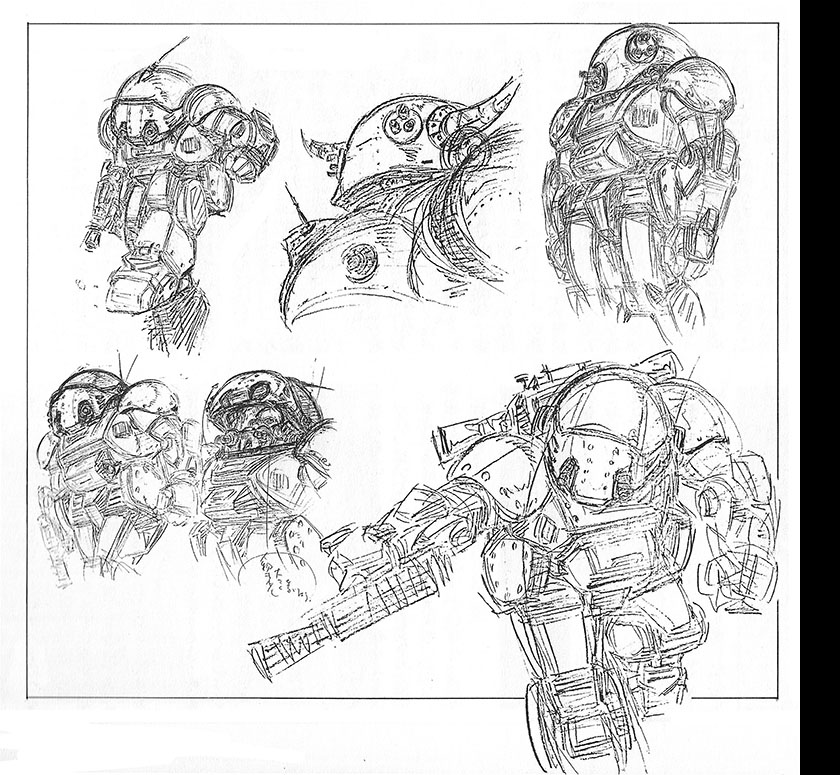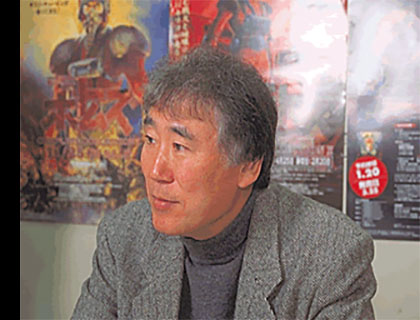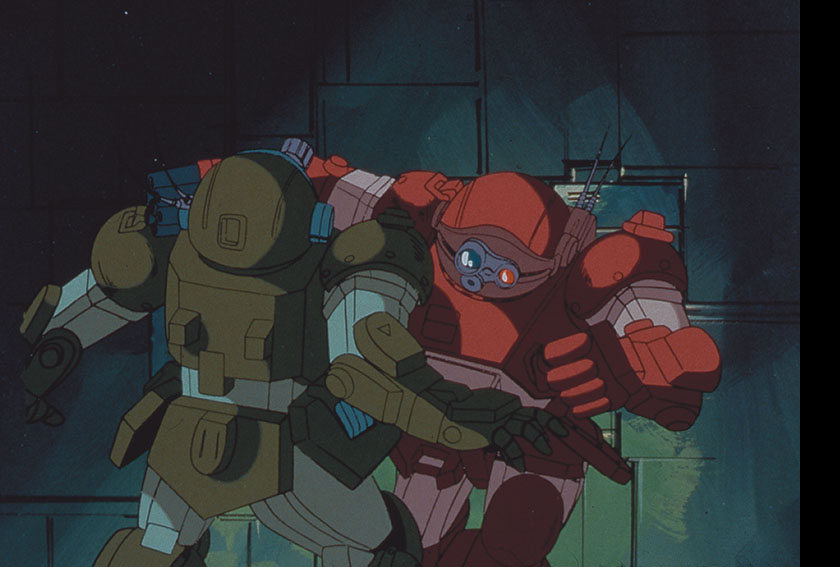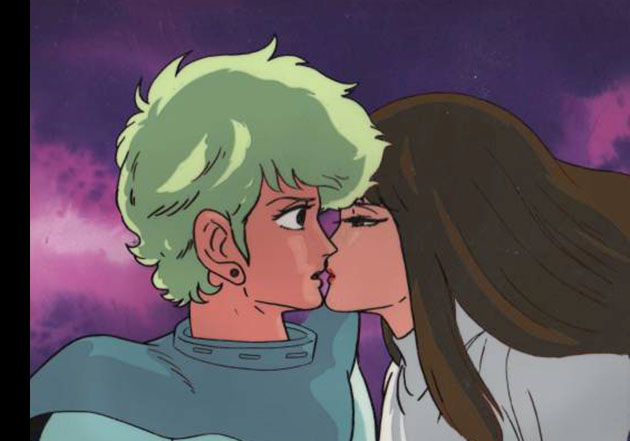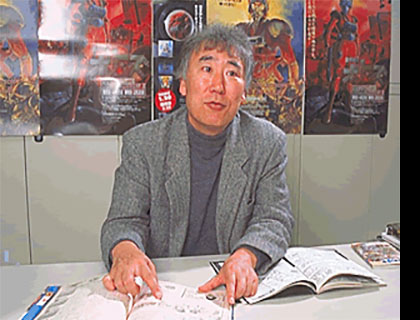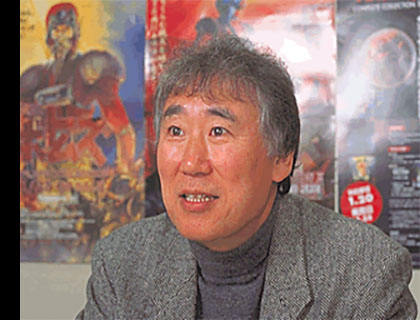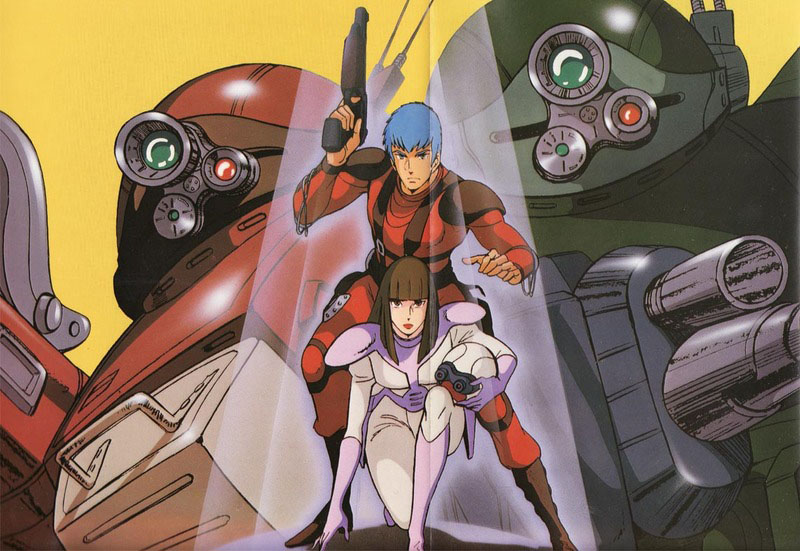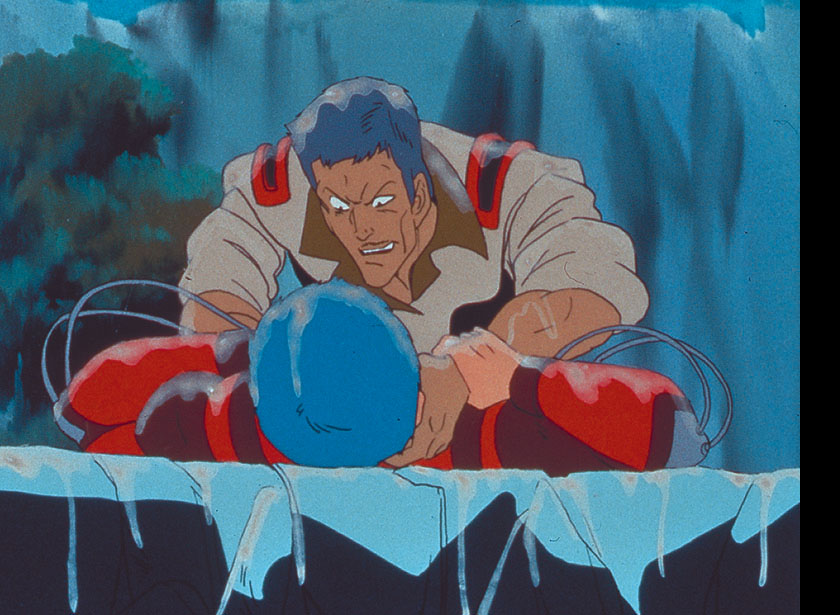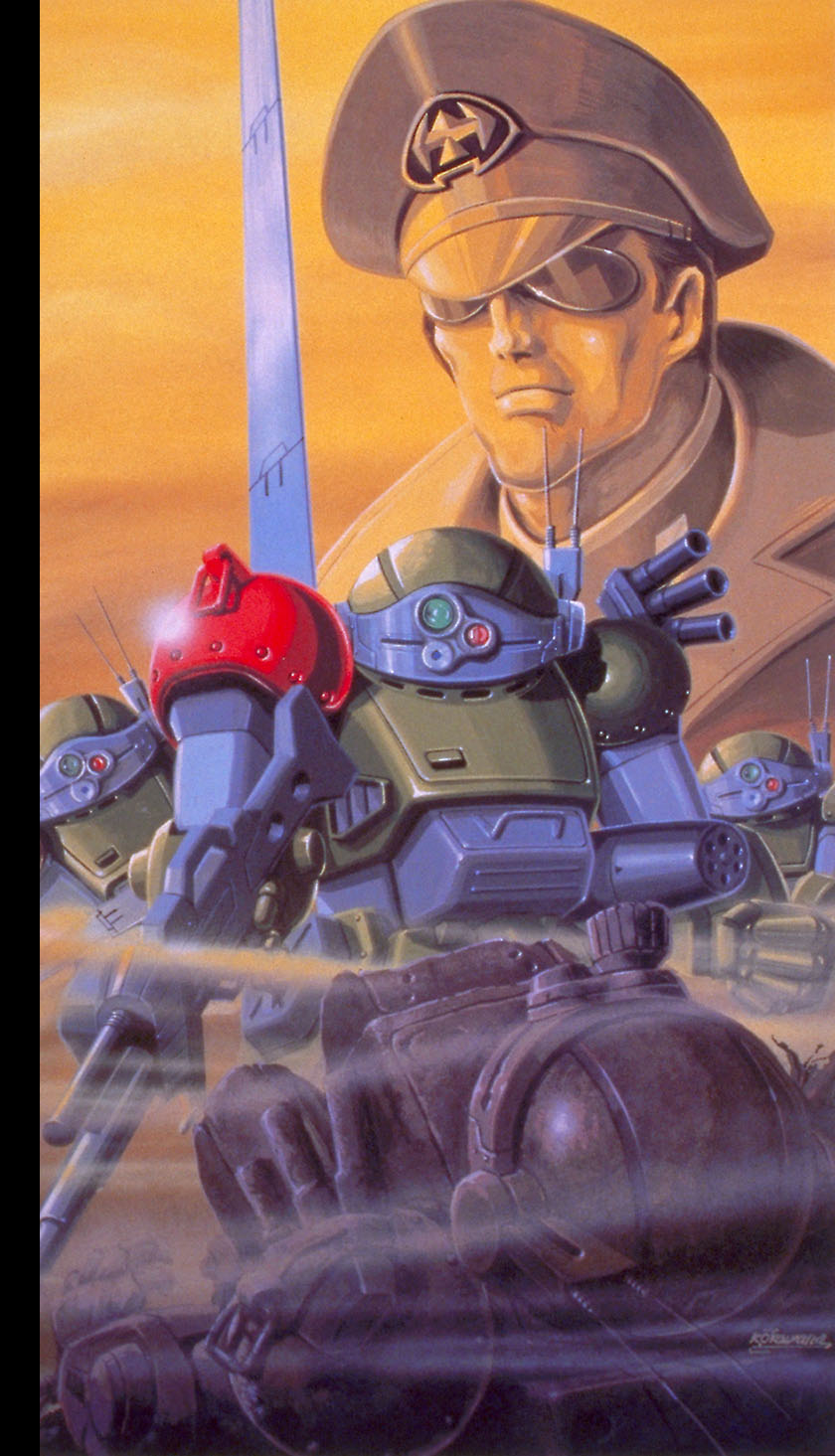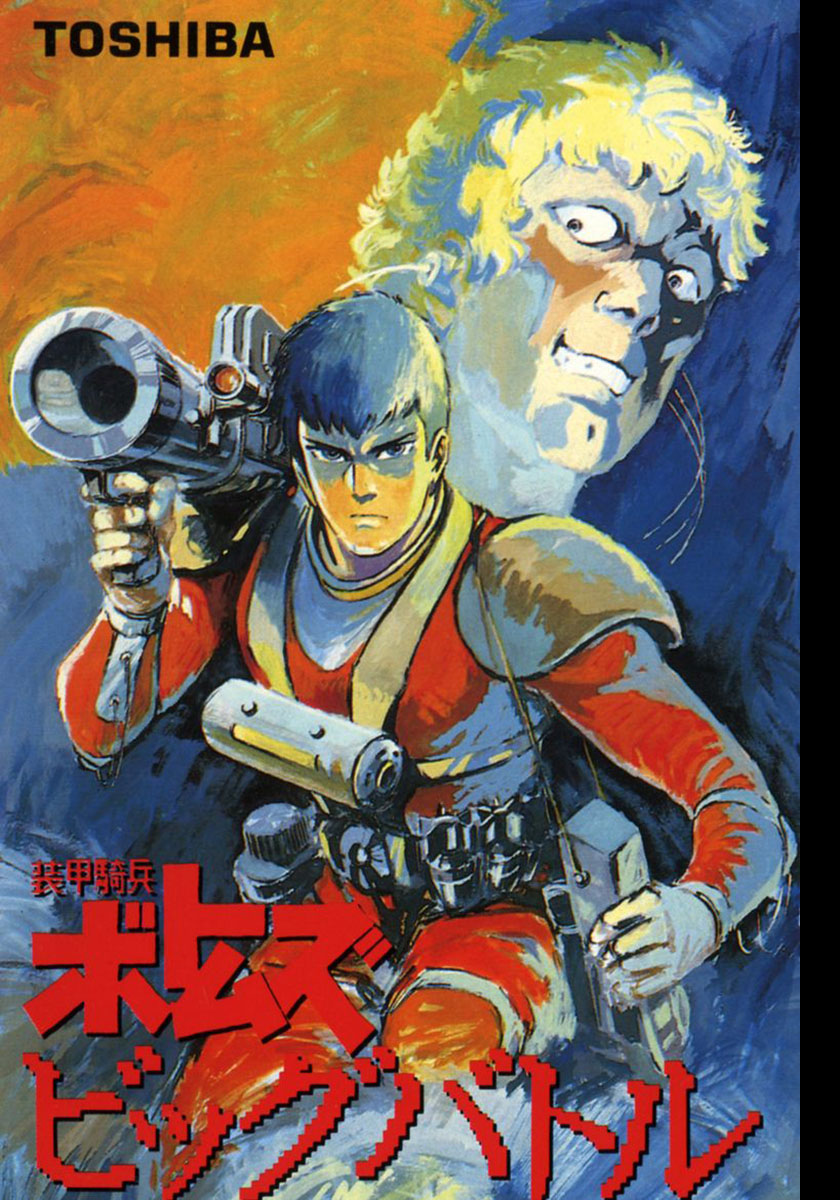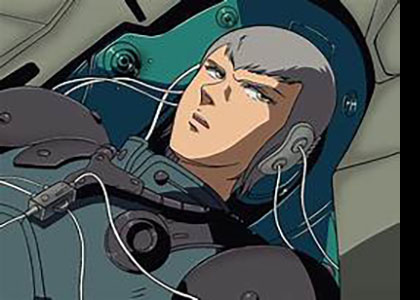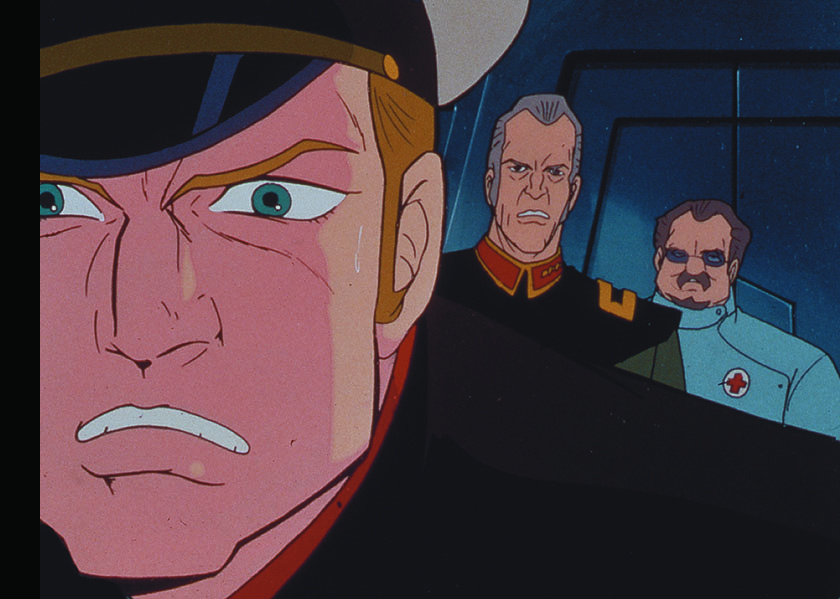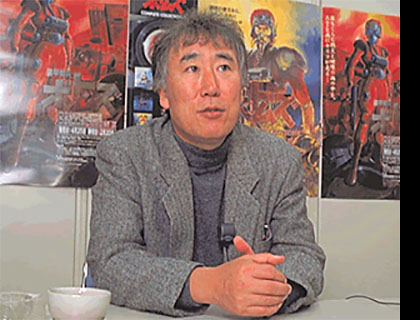Ryosuke Takahashi interview, 1997
Ryosuke Takahashi started as a writer and made his way up the anime production ladder as one of the few directors who couldn’t draw, but was very adept at storytelling. He added “series creator” to his resume with Fang of the Sun Dougram in 1981 and continued with Votoms, Galient, SPT Layzner, Gasaraki, and many others. (See his full list of credits here.)
This interview, published in Armored Trooper Votoms Digital Memorials (1998), caught up with him in the wake of Shining Heresy and looked back on everything that brought the series to that point.
I only wrote the script for Episode 4, Battling
First of all, please tell us how Votoms came about.
I was working on Dougram at the time, and this was planned as the next program. At first, we were planning a fantasy like Galient. I wanted the main character to be a little more openly emotional within that world. He may be a man of action, but he is not a moralist, and in some cases he may be a villain. I was working on a picaresque character (rough but appealing). But at that point, I wasn’t sure about putting robots in a Galient-like world, so we made a major change in the direction of the project and it became Votoms.
I also heard that a model brought in by Kunio Okawara was the trigger.
That was one of the triggers. There was a wooden mecha that Mr. Okawara had made himself, painted in military colors. The size was slightly smaller than the A.T. in Votoms. It was not scaled to accommodate a passenger. When I saw it, I was inspired to see if I could create a project in that direction.
I’m not very good at big battles between organizations. Also, when I was a child, movies were the only entertainment available, and at one point in my life, movies from Nikkatsu studio were the most popular. The main characters were all drifters with no family members in front or behind them. I wanted to create a protagonist who could stand on his own. I was also inspired by many other films. For example, Junior Bonner, which is a film about a rodeo champion who travels from city to city with a horse in a trailer through the countryside of the United States.
I wanted to make something up with a robot as the horse, which you could get onto and ride around. I came up with the idea of having robots show up somewhere and fight with other robots. I thought I could create the kind of worldview I wanted with the appearance of robots and drifters. The size of the robot, including maintenance, was decided to be something that could be owned by an individual.
I was also brought up in an era that still had the scent of postwar Japan. MPs were driving jeeps around town back then. After a while, construction workers and others were riding in these vehicles. Our generation had a strong nostalgia for that era. Mr. Okawara even drove a Wrangler for a while. In addition, magazines and other media have introduced sports in which people ride jeeps over rough roads. I saw a jeep with big tires running through a muddy area and thought, “That’s good.” That’s a different dimension from robotics.
Those things took hold and settled in my mind one by one and became established. From there, the jeep, which had been a military thing, was released into the city after the war ended, and builders bought them because they were just right for construction sites and the like.
Just like that, this world was born when the war ended and A.T.s were no longer needed, or were overproduced and released into the city. In essence, it becomes just scrap iron, and even though war is unpleasant, if you hear that tanks are going to have a mock battle, you’ll want to go see it, won’t you? So instead of robots fighting a war, I thought that if we had a mock battle between robots, it would probably work as a show.
On the other hand, if the war that was supposed to continue was to suddenly end for some reason, some soldiers, like Chirico, would have been in the war as boy soldiers for as long as they could remember. Some cannot find a methodology to survive in a city. It would not be surprising, then, if A.T. riders were in the business of using robots released into the city to fight mock battles and earn bounties.
The first thing that came to mind was a story about a protagonist who goes from town to town in a world where such mock battles are extremely common. The only script I wrote was for Episode 4, Battling. These were all the prototypes. We fleshed out these images in various ways and the 52 episodes of Votoms as we know it came together.
So in my mind, the core of Votoms was about a young man who does robot pro wrestling and walks from town to town. Then I started to think about how to integrate it into the next project after Dougram. I started working on it with the help of our staff members. In the conceptual stage, it was more about making a resolution than creating it.
What was the specific pitch you made to the staff?
I wanted to make the main character someone who stands out from the crowd by including various things that make him different from the average person. But I wanted to make it simple, not complicated. While he’s very good at riding an A.T., I wanted him to have some kind of tragedy.
The initial idea was that he had been thrown out of town, having known nothing but war. As I applied this protagonist to the larger composition that I had in mind, I was able to create a new character. The writers and the concept people attached various attributes to him. The fatal tragedy of being incompetent as a person was a burden he had to bear.
The biggest pitch was about Wiseman, who comes up later in this world under the name God. Wiseman is not so much a religious god as he is a man who holds all the power. A being capable of doing anything that is possible when it comes to human society. In other words, if there is such a thing as God, Wiseman is a being that holds power as close to that as possible. Of course, such a powerful person is not God, so there is some fear in calling himself God. But he’s also the closest thing to the concept of a God. He’s thinking, “Could I become one?” and has that desire.
When I thought, “how do I express the fear that someone close to God feels like God?” I came up with the idea of Chirico as a being at the opposite end of the power spectrum. In the end, he has only his own body. God is a being that wants power and control, and Chirico as his opposite rejects both domination and non-domination. How does he do this? With his own body and spirit.
He is only a small piece of metal in the eyes of the would-be god. At the very beginning, I presented Chirico with the metaphor of a broken needle stabbing into the heart. If a giant were to be stabbed with that needle, as the myth goes, and if it gets into the blood vessels, it gets closer to the heart. And if it gets into the heart, “it would not be good.”
Wiseman is trying to divine whether he is a god or not by letting Chirico swim around. He’s dangerous, but he’s allowed to play around until he reaches the heart and it becomes fatal. Then, if Wiseman can remove him, it will have no effect. He assumes that if he can remove the last thorn from his side, he will reach Godhood. So, though Chirico is very dangerous man, Wiseman lets him play in his world. But in the end, he cannot remove that thorn. Chirico stabs at the heart of the divine and destroys it.
We created this big structure and asked everyone to season it in various ways. As the script progressed, Soji Yoshikawa came up with the word “incompetent” for Chirico. That was interesting, so we decided to use the term to describe Chirico’s attributes. These things came up while we were working on it.
In the concept stage, it was more a matter of making preparations rather than creating. For example, whether or not a 4-meter robot would be acceptable. The robots in Dougram were a little over 8 meters. I thought that if I were to replace the robot in Dougram with a weapon, I would depict it as a tank. However, when I tried to depict an 8-meter robot in the field of animation, they’re all strong and large whether they’re 8 meters or 50 meters. Otakus may know the difference between Dougram and Gundam, but others won’t be able to differentiate between the two.
In reality, there isn’t much of a difference in the size to the people directing on-site. If 8 meters is the same as 50 meters, then I wondered how small I could make it so that the audience would be able to perceive the size, which led to it being 4 meters. If it were smaller than that, it would feel more like a powered suit, worn rather than ridden.
We decided on the size of the A.T. based on the idea that this was the smallest size that would be recognizable as a robot. Then the question arose as to whether children would recognize a robot that small as a strong entity. Confirming such a decision is a matter of making resolutions. So, rather than making it up as we went along, we tried to dispel the anxieties one by one. It was a process of reaching a common view among the staff. When we decided on 4 meters, we were all thinking about the minuses, but we found ways to shake that off.
The decisions I made, even though I thought they were a little rough, turned out to be for the better
Why did you choose a four-part story?
Mr. Numamoto, who was in many ways the center of [toy company] Takara, asked me to write the story as a refraction of Dougram. He said, “I think Dougram is artistically weak because it doesn’t smell like science fiction, even though I recognize it as science fiction.” That was something I did intentionally. You might say it came out as a minus instead of a plus.
I was told to strengthen the visuals. However, if we fixated on a single visual world, we might fail again. So I decided to put in all the visual worlds I wanted to see and cut it into four pieces. The first arc shows a city where the war is over and a spaceship is stuck diagonally into the ground. In other words, when we think of the most SF-like city, it’s a city of the future.
Next, I wanted to move to the opposite side of the spectrum, where nature is densely populated. I also had the image of the Vietnam War in my mind. From there, I came up with Kummen. Therefore, the four-part structure was born from the idea of enriching the visual world.
However, there was some concern among others about what to do with the space between each of the parts. If we just jumped to the next page and intentionally left a missing link between the two, it would be something unrefined that would surely create dynamism in the story.
Did you have any difficulties in the production of Dougram?
I didn’t think it was very difficult, because it was my happiest period. Dougram did well for Takara. Even for the TV station, the results were very good in that time slot. But it didn’t have a very good reputation in anime magazines. It hurt to have a bad reputation, but the sales relationship was good on the broadcast side, so I was allowed to make my next work with the same mood that I, Ryosuke Takahashi, had as a creator.
That’s why Votoms came out better. There were no restrictions, and I was given even more help and support. I have more good memories than bad ones about the work. However, the initial performance of Votoms was not as good as expected, which led to some restrictions being set on Galient. For example, in Votoms, the robots do not have human-like faces. In Galient, they had to have faces, or swords, or something.
But there were no real difficulties in Votoms, like when we chose to make the robots smaller. Since the main character is a soldier, he’s a pawn, so I was free to do things like not having his face be visible when he’s in the robot. I could also put a goggle on the robot and have various information flow from the goggle. Even if it was said, “Oh, you can’t see the main character’s face?” it was the next show after Dougram, it was like, “It’s okay, it’s okay.” I was given a lot of room to make decisions.
These things, one by one, created the mood for Votoms, and I think it formed the essence of the work. Therefore, it was possible to divide it into four stages and fly wildly through them. Even if they asked, “Can you do that without any context?” I’d answer, “Don’t worry, I’ll make it work.” In fact, I was not at all confident, but I was able to get that far.
Also, the decisions I made, even though I thought they were a little rough, turned out to be for the better. When making the first OVA, I was looking for elements that would connect, and it was like, “Are you sure it’s going to work?” Coincidentally, when Mr. Yoshikawa first brought Chirico to Kummen, he had him say, “I came here to forget everything.” Before that, he was in a pretty good place with a woman named Fyana, confirming their feelings for each other, but they were separated during the fighting.
While I was wondering why he left the stage and came back looking more nihilistic, I was able to make an OVA that actually told this kind of story; the birth of Ypsilon and the encounter with Fyana. In order to save the unconscious and helpless Chirico, Fyana kisses Ypsilon under the guise of teaching him love. However, Chirico regains consciousness and sees the woman he thought loved him kissing another man.
He felt something like despair and the OVA fit perfectly into the story of him coming to Kummen in desperation because he lost her again to the Secret Society. It happened completely by chance. There were a lot of lucky things like that.
I didn’t start out thinking I would write all of the trailer narration
What did you do yourself as a director in the actual production?
Usually, the person who edits the next-episode trailer is the same person who writes the narration. The visuals I wanted were not available in time for the schedule, so I told them to use whatever shots they wanted, and I would write the narration, since I knew the whole story. So the person who selected the visuals and the person who wrote the narration were separate. I was glad to see it flow and feel no mismatch.
At first, I didn’t think of writing all of the narration. I was planning to hand it over to someone else after a system was created. But then I thought, “No one can make such a system, how do I make it?” And I decided to write it all myself.
I was a little embarrassed at first, but the people around me who heard the first one said it was good, so I continued with it. It was also fortunate that it was voiced by Banjou Ginga. However, the first preview had a huge retake count. The sound director retook his voice 48 times in almost an hour. I was standing next to him and felt sorry for him. I was listening, wondering if it was OK to inflict something like torture.
I still don’t know why it had so many retakes. It might be that they were hardened by recording so much. Later, Mr. Imanishi recorded only the trailers and listened to them himself. We even put out a video with just the trailers, just to see if there were people like that.
Were the episode titles also your suggestion?
Yes. I tried to avoid using modifiers and verbs as much as possible. We decided to make them just two or three kanji characters. The first episode started with 『終戦』 (The End of the War). I thought about continuing in this vein with two kanji characters, but if I stuck to that, it would be too much.
For example, we included Assemble EX-10 and Red Shoulder. I immediately made Uoodo the title of Episode 2. Well, I guess it was good to have freedom in this area. It makes a big difference if you have a policy or not. Once we had a policy, I think the balance of when we could vary it became a plus again.
You used many difficult kanji and phrases in the titles. Did you consult a dictionary?
I didn’t. It was already in my mind. Of course, I did check the text because I didn’t want to make any mistakes in writing. I went into a coffee shop called “Olive” near the APU Studio in Shibuya on the day I was going in to make the trailer. I would read manga for 45 minutes and write in the remaining 15 minutes. Sometimes I couldn’t do it, so I wrote in the midst of recording an episode. There were times when I finished writing it after recording was over.
However, I have a better balance than other directors. I tend to tell stories rather than make visuals, so I don’t think about it too much in advance. I wrote what came naturally from the script in my head, just going with the flow. In the end, the work done by the staff and my work as the director were roughly the same. The trailer is just a small part of a film that fits well together.
In addition, Director Takizawa really stepped up to the plate in the in-between areas. It worked well, too. So Votoms is a lucky piece of work, isn’t it? I think so.
After all, it was Uoodo that decided Votoms
What story or character has left a particularly strong impression on you?
During the production, we had said that it was a story about the rehabilitation of a mentally-ill boy soldier. He regains his humanity through the rehabilitation of travel. So naturally, he was set up to not open up to people at first.
In Episode 9, when Chirico speaks to Gotho and Vanilla, who were only hanging on because of their interest in gold coins, he says to them, “Thanks to you, I was saved.” The three people who are listening react in a very different way. What did he say to us? It was a very unexpected scene.
He was just saying thank you, but the story was that Chirico’s rough feelings were healed a little. Everyone was puzzled, but when Coconna responds, “We’re all friends, aren’t we?” Chirico says, “It’s kind of embarrassing to be a friend” in his monologue. The word “friends” is a phrase that spreads warmly in the hearts of the audience. I was strongly impressed with this exchange because I consciously wanted to have good timing for those feelings.
If I were to talk about my favorite stage, I would first say Uoodo. After all, it was Uoodo that decided Votoms for me. And then Kummen. For a generation like mine that was born during the war, the first thing that comes to mind when we think of war is World War II. During my childhood, there was a flood of Japanese and American-made war movies about it. It’s not that I don’t like them. When I think of war, whether in literature or images, the first thing that comes to mind is World War II.
But in my family, I was an only child with a single mother. My father died in the war, so she avoided the war movies, and I never saw them. So the Vietnam War, which became the image of Kummen, was strongly established in my mind. It was a very sensitive time for me, and there were many news reports and movies about it.
In the Kummen stage I wanted to focus strongly on the feelings of King Kanjelman. I also like the positioning of the characters. Kan Yu, who was just a nasty soldier we threw in spontaneously, became a good character. One of the reasons for this is that the voice actor, Masashi Hirose, was very good. After that, I worked with Mr. Hirose for a long time as a villain and in sharp-edged roles through SPT Layzner.
I’d entrusted Chirico with what I wanted him to do and put it into the 52 episodes of Votoms. I felt like I didn’t have to do it when it came to the OVAs
The Red Shoulders are the main focus of the OVAs. Was that your suggestion?
The direction of what we wanted to do came from within the staff. Votoms itself is a sober work for mecha. The robots are not named one by one. I came up with “red shoulder” because I thought an A.T. would look better as a character if the shoulders were painted red. I thought a “red shoulder” would be a good way to show Chirico’s intention to strike out as a violent soldier.
Unexpectedly, the words “blood-sucking squad” and “Red Shoulder” somehow began to take on a life of their own within the staff. Also, people outside the staff who worked on Votoms books seemed to like “Red Shoulder” a lot. The question arose as to what kind of military man would have wanted to create a unit called “Red Shoulder,” and the spotlight fell on Yoran Pailsen.
I was thinking of Charles Bronson and others in Western movies. I like the voice of Chikao Otsuka, who used to play more villainous roles. I wanted to use Pailsen in key moments, so I asked him to play the role. With Mr. Otsuka’s voice, I thought of Pailsen as a heavy character who is fatally driven by something he’s obsessed with, so I thought it would be possible to create an OVA in the form of a conflict with him, the founder of the Red Shoulders.
Actually, Soji Yoshikawa wanted to contrast the name Last Red Shoulder with First Red Shoulder afterward, but we decided not to do it because we thought it might be laughable at the time. [Trivia note: this references the OVA Roots of Ambition. When Yoshikawa wrote the novelization, he reverted to his preferred title, First Red Shoulder.]
We also made Big Battle in response to a request to take a plunge into a big action episode of the story. Some people said that it strayed from the main path of Votoms, but I think that was a good thing, because it broadened the worldview.
In Roots of Ambition, you depict Pailsen’s encounter with Chirico, his childhood protégé. What did you want to portray there?
I sometimes cheat on the small details. They’re foggy. Votoms is essentially a mood piece. If Chirico has a mood, I try not to destroy that mood.
What did you try to depict in The Shining Heresy?
We didn’t put Fyana in Roots of Ambition, and the demand was strong to show Chirico and Fyana together. By the way, Votoms is not so much a robot story as it is a rare pure love story. The main thing is that it’s a tough melodrama. So, there are people who don’t like anything that doesn’t include Fyana, no matter how good it is. Mr. Inoue, the current editor-in-chief of Newtype magazine (at the time of the interview) is a case in point.
I was thinking about what to do with Fyana. Chirico is always saying, “Fyana, Fyana,” but I wondered what would happen if another woman appeared. I introduced Titania because of the influence of Aliens and other movies with strong women at that time. I’d entrusted Chirico with what I wanted him to do and put it into the 52 episodes of Votoms. I felt like I didn’t have to do it when it came to the OVAs. However, some of the staff wanted to try different things. So we decided to make it this way.
What was the purpose of Fyana’s death?
I’ve gotten a lot of backlash for that. Rather than giving it a purpose, I wanted to see if someone like Titania could replace Fyana. But I haven’t come to a conclusion on this yet, because I haven’t made the next one.
When I thought about the final episode, I didn’t want to make any sequels. I should have stuck to filling in the missing links in the TV series like I did with the OVAs before that. But there was a strong desire to see Chirico move beyond the 52 episodes.
Naturally, the sales side came to us with such opinions at the planning stage. I was a bit reluctant about it. It wasn’t like I was pushed aside at the time. I guess it was because there was a bit of a gap in my mind. So, in retrospect, I could have set the theme of Shining Heresy prior to the final episode. For example, the fact that Fyana’s life is not saved is also done in the TV series.
I think there might have been a more OVA-oriented approach. But, well, what’s made is made, and can’t be erased.
I want to maintain the Votoms world in the future
What happens further down the road?
The next theme is whether Titania could become Fyana. In short, she’s made it clear that she will follow Chirico forever. Could Chirico accept her as Fyana’s successor? That’s the thing. If not, can the hole left by Fyana’s disappearance be filled by me as the creator? Will Fyana be resurrected with some kind of device? That will be the theme.
But the field has changed, and I don’t think we will make it. Votoms has a small amount of information. It doesn’t have large allowances like Gundam, where it’s OK to have various Gundams, but there are many people who say Votoms is somewhat narrow, or that they don’t like the spinoffs. There was a lot of pain with Merowlink.
Is it still Votoms without Chirico?
When it came to Chirico, I was conscious of Golgo 13. Not because of the content, but because I feel the position of Golgo 13 is very philosophical. There are some works that have a little bit of sentiment in them. I feel that there is something profound about killing anyone if your conditions for payment are met. It’s totally different from what we think of as humanity or justice.
There is a kind of killer machine that exists in a place outside human society. I think it’s a kind of safety valve for the world. I feel that Golgo 13 is a device for this purpose. That is the singular presence of Chirico in Votoms, to put a stop to the attempts of those in power to gain a higher level of power. In other words, Chirico is also a safety valve, a device like a thermostat.
Likewise, I feel there is such a thing in the real world. Even though it’s a great tragedy for us, wars happen when things reach a certain point. I think that there’s a way to stop war that has a dimension beyond good or bad. And there are not just one or two such devices. I have a feeling that the sudden decline in the birth rate [in Japan] is actually due to that mechanism.
Rochina can also be considered a device, can’t he?
Rochina is a kind of storyteller. I really like the character of Rochina. If he were content in that area, he could actually be in a good position. But he has a thirst, and he’s not satisfied with it, and he wants to go up in the world. However, it’s difficult to reach the top. I like such secular people. In The Shining Heresy, he says, “I am enlightened. On the other hand, I know nothing.”
Finally, please give a message to Votoms fans.
Until a few years ago, I wasn’t sure about the world of Votoms. If Sunrise had asked me to let someone else do Votoms, I have a feeling I would have said, “Oh, that’s fine.” If someone said they want to develop the world of Votoms, making a story of a battling champion, for example, I might have nodded my head. But now that I’ve come this far, I think it’s better to protect that world, even if it is narrow.
I don’t mind if someone other than myself directs a new one, but I want to keep it in that world. It’s impossible for me not to be involved at all. I want to protect the world of Votoms, the mood of Votoms, and the invisible constraints of Votoms. In any case, if circumstances allow it to happen, it’s not something I can do alone.
Thank you very much for your time today.
Recorded at Sunrise, November 14, 1997

